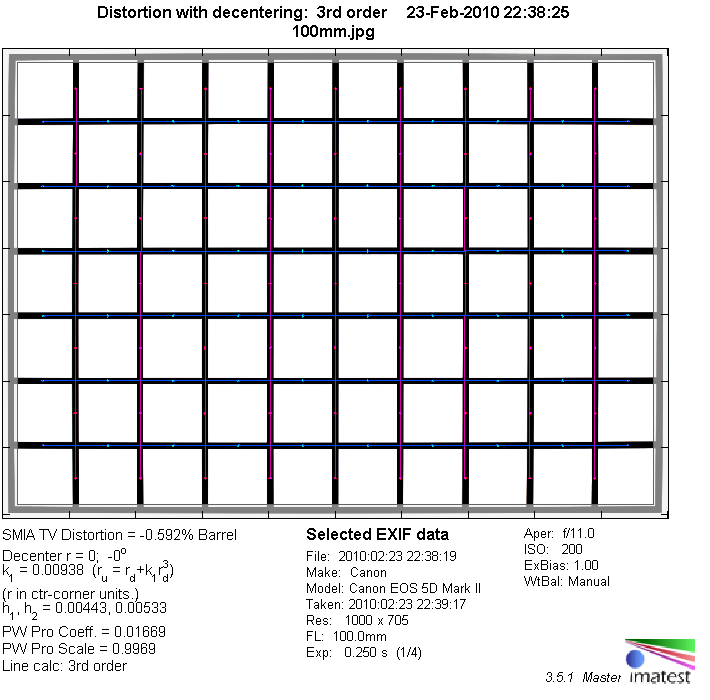|
Canon EF 100mm f/2.8 USM macro (full format) - Review / Test Report - Analysis |
|
Lens Reviews -
Canon EOS (Full Format)
|
|
Page 2 of 3

Distortion
Typical for prime lenses and especially for a macro lens the level of distortion is very low at only
0.6% (barrel type). This is usually nothing to worry about in field conditions.

Vignetting
Full format DSLRs are quite demanding with respect to vignetting but the Canon lens performs comparatively well here.
At f/2.8 it produces a edge shading of ~1.2EV - this is certainly visible in critical situations but many lens are
worse here. The problem is pretty much resolved at f/4 and negligible from f/5.6 onwards.

MTF (resolution)
Typical for most macro lenses the EF 100mm f/2.8 USM macro performed very impressive in the MTF lab.
The lens is already capable of delivering an excellent center performance at f/2.8 followed by very good
borders/corners. The peak performance is reached between f/5.6-8 although the additional gain in quality by stopping down
is actually quite limited. The lens remains perfectly usable till about f/16. At f/22 diffraction effects are reducing
the quality to good (just) levels. Everything beyond should be strictly avoided - this is a physical limitation and
not a design problem.
Please note that the MTF results are not directly comparable across the different systems!
Below is a simplified summary of the formal findings. The chart shows line widths per picture height (LW/PH) which can be taken as a measure for sharpness.
If you want to know more about the MTF50 figures you may check out the corresponding Imatest Explanations
Chromatic Aberrations (CAs)
Lateral chromatic aberrations (color shadows at harsh contrast transitions) are very low and really nothing to worry about.

Bokeh
The bokeh (the quality of the out-of-focus blur) is a primary aspect for a macro lens and the Canon lens is a good performer here.
Out-of-focus highlights are very uniform and perfectly circular at f/2.8. The highlights deteriorate a little when stopping down -
upon closer observation you can spot some small traces of outlining at f/5.6. The critical focus transition zones are decently
rendered but not as as smooth as on the 100mm L lens.

Bokeh Fringing / Longitudinal Chromatic Aberrations (LoCA)
Bokeh fringing is a problem which is present in most large aperture lenses but the EF 100mm f/2.8 performs better than most here.
At f/2.8 there's a bit of fringing visible but it's not overly significant - if you observe the provided sample crops (f/2.8) below you
may be able to spot traces of green (rear) & purple (front) halos in the focus transition zones. However, the problem is already very
hard to spot at f/4 and it's basically gone by f/5.6.
|
Move the mouse cursor over the f-stop marks below to observe the respective LoCAs
|
| f/2.8 |
f/4 |
f/5.6 |
|

|
|